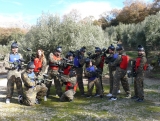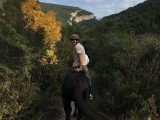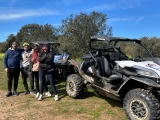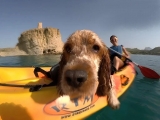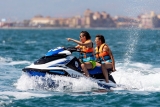However, beware! If you don’t have any diving certification, you should always rely on professionals to ensure the activity is conducted safely and that you’re out of danger.
Want to know more? Read: PADI Diving Certifications
On the other hand, it’s important to consider the available diving courses, as well as the locations where you can practise this sport, but above all, it’s vital to enjoy this activity with the utmost safety. That’s why it’s useful to know the following rescue techniques. How to...
Handle a cramp

The technique involves holding the tip of the fin on the affected leg and pulling it progressively, gently stretching the involved muscles to relieve the strong contraction. Your buddy can assist by giving gentle massages to the affected area or holding you to help maintain balance.
Exit the water on a beach with strong waves
This way, you avoid being knocked down by the waves and tossed around. Stay close to your buddy and, if necessary, hold hands while using your other hand to secure your regulator and mask.
Swim with the scuba unit held between your arms
Underwater, remove your scuba unit. Once it’s free from your body and only connected via the regulator mouthpiece, breathe normally and position the scuba unit so the valve faces forward, towards your intended direction.
Carefully tuck the octopus inside your BCD, fold it as if laying it flat on a boat, and with the hose and pressure gauge exposed, hold the tank and gradually inflate the BCD to achieve neutral buoyancy. Proceed to swim as usual, but this time controlling buoyancy only via the hose. At around 20 metres, you can reposition the BCD as normal.
Recover and ascend with a conscious buddy
Check if they’re exhaling bubbles through their regulator—whether at a normal or rapid pace—to gauge their state. Depending on the situation, calm them down and initiate the ascent.

To do this, deflate their BCD, grip their shoulder strap firmly, and control the ascent using your BCD. Perform the ascent face-to-face, maintaining eye contact, and manage buoyancy by holding their BCD while deflating yours as you near the surface to ensure controlled buoyancy.
Recover and ascend with an unconscious buddy using your BCD
Approach them quickly, checking their condition: breathing, bubble output... If they’ve dropped the mouthpiece, verify if their regulator is releasing air and check the pressure gauge. If there’s no pressure, place your octopus in their mouth while gently pressing the purge button to clear it of water.
Position yourself behind them, pass your right arm under their BCD and armpit, using that hand to secure their regulator and tilt their head back slightly to prevent glottis blockage during ascent. This grip ensures they won’t slip away, keeping them level with you.
With your other hand, adjust your BCD to modify buoyancy. Maintain a safe ascent rate—speed won’t help and may worsen their state. Once surfaced, inflate their BCD, call for help, and begin first aid.
Recover and ascend with an unconscious buddy using their BCD
With your other hand, adjust their BCD for buoyancy, then follow the same steps as above. This technique is recommended when the injured buddy is much larger than you, as their BCD offers better buoyancy control.
Tow a diver on the surface
Once surfaced, if the diver is conscious, inflate their BCD for positive buoyancy. Hold them by the tank valve (from behind), keeping their face above water while towing and reassuring them verbally.

Another towing method: inflate your BCD for positive buoyancy. Have them lie on their back while you place your shoulders under their feet and hands on their legs. This lets you steer while monitoring their condition.
If the diver is unconscious, inflate their BCD and signal the boat crew or shore team to initiate emergency protocols. Position the victim chest-to-chest, with their head above water, and secure them by passing your right arm under their armpit and BCD strap.
Use your right hand to lift their chin and keep their regulator and purge button accessible. Monitor their breathing and keep talking—even if unconscious—to provide reassurance.
How to ventilate an unconscious buddy with the regulator while surface towing
Once surfaced with an unconscious, non-breathing buddy, inflate their BCD for buoyancy but avoid chest compression. In calm seas, loosen their BCD buckle slightly.

Signal the boat crew to retrieve you and begin evacuation. Purge their regulator before placing it in their mouth to clear water and confirm airflow.
If no air flows, use your octopus, purging gently every ~5 seconds to avoid injury.
Hold their chin and regulator to ensure a seal, and pinch their nose with your other hand to open airways. Watch for chest rise with each purge. If no expansion occurs, airways may be blocked.
While towing, you can swim backwards, holding them from behind with their airways open. Upon reaching the boat, remove excess gear while continuing rescue breaths.
Practise this in a pool or during calm post-dive exits.
Remember: enter the water feet together
From a high-sided boat without a platform, perform a vertical entry. After gearing up, slightly inflate your BCD, stand at the edge holding your regulator and mask with one hand and your console and hose with the other.
Place the regulator in your mouth, ensure you won’t land on anyone, then execute a giant stride while facing the horizon. Immediately bring your feet together (heels touching) upon entry.

You may never need these techniques, but knowing them makes diving as safe as it is fun.





